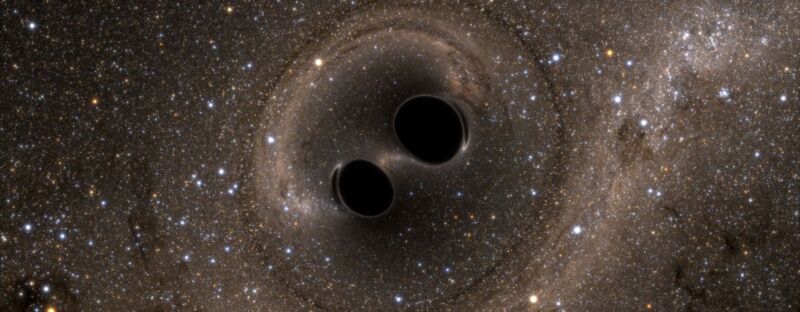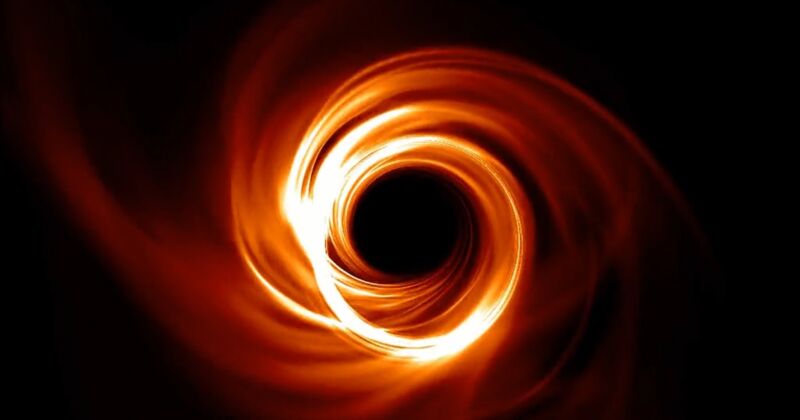
The advent of gravitational wave detectors—there are now four of them—has recorded a steady flow of black hole mergers. As far as we can tell, almost all of them have behaved exactly as we would expect for the sorts of events that we had predicted would produce them: a pair of orbiting black holes that gradually spiral inward until they meet at their mutual center of gravity.
But there was one event that apparently didn't quite match the sorts of signals we would expect. And researchers are now suggesting it was the product of something that should be incredibly rare: two black holes finding each other in the vastness of space. After a single close pass, the two bodies curved around and immediately swung into a collision.
Templates and chirps
Black hole collisions require that the two black holes be close enough to each other to gravitationally interact. Since space is so vast, this would typically mean that they are the products of two massive stars that formed as a binary system. After the stars died and left black holes behind, the two bodies would slowly spiral in toward each other, radiating away energy in the form of gravitational waves as they do.
This leads to a relatively straightforward inspiral and merger, the details of which have appeared in countless animations in the wake of LIGO's first detection of a black hole collision.
Collisions of this sort are so well worked out that we have a large set of simulations that model a collision like this with different sets of details: different black hole masses, different spins, and so on. These simulations provide "templates" of the final few moments before the collisions, when the production of gravitational waves becomes both faster and more intense, with the final "chirp" of waves rising above the background noise on Earth. These templates allow us to quickly identify the details of a collision, based on how closely the collision's signals match one of these templates.
But a merger called GW190521 didn't really fit templates especially well and only matched best if the black holes involved weren't spinning at all. The chirp was unusually short, and there is no sign of a signal prior to the actual merger. Finally, both of the objects involved in the merger were relatively massive: about 50 and 80 times the mass of the Sun. Black holes of this size don't form in supernovae (those typically start out with less than 15 solar masses), so these are likely the products of prior collisions. Which makes having them start out as part of a binary system a questionable proposition.
So, a team of European researchers decided to model an event that should be relatively uncommon: the two black holes didn't start out in a mutual orbit but happened to pass close enough to gravitationally latch onto each other.
Shall we dance?
The technical term for what the authors are proposing is "dynamical capture," which explains the apparently sudden, burst-like nature of the GW190521 signal. Instead of the gradual approach where the gravitational waves build in intensity that characterizes binary systems, the two bodies that triggered this event could experience a limited number of high-velocity swings past each other before a collision.
The researchers modeled a variety of potential approaches, some of which would lead to a gradual approach similar to that seen in binary systems and others that could send both black holes away from each other on altered trajectories. But in between the two extremes is a set of results where you could either have a small number of close passes before collision, or the two black holes could plunge directly into each other.
The models that produced a chirp that best matched the GW190521 signal saw a single pass that drew the black holes closer, followed by a single rapid curve into the collision. But the first pass was distant enough that the signal would be too low to stand out above the background noise in the detectors. While it's possible to produce similar results to this using a more typical collision profile with a gradual inspiral, various statistical tests suggest that the dynamical capture is more likely.
That's probably based on the properties of the gravitational wave chirp, at least. The probability of two black holes getting close enough to each other to trigger the process is a different matter entirely. But these two black holes are massive enough that they've likely been built by previous mergers, suggesting that this collision took place in a dense cluster where lots of massive stars are dying. So, the environment may be more favorable to a chance encounter than we might expect.
Nature Astronomy, 2022. DOI: 10.1038/s41550-022-01813-w (About DOIs).



3175x175(CURRENT).thumb.jpg.b05acc060982b36f5891ba728e6d953c.jpg)
Recommended Comments
There are no comments to display.
Join the conversation
You can post now and register later. If you have an account, sign in now to post with your account.
Note: Your post will require moderator approval before it will be visible.